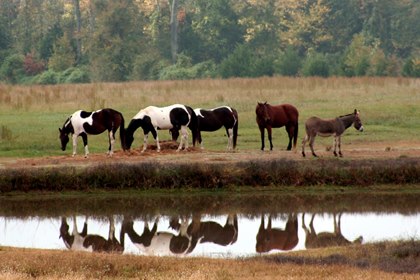
By Christa Lesté-Lasserre, MA
Published on The Horse.com
As a “natural” part of this world, horses might seem like a positive addition to the ecosystem. But civilization and modern management systems can dampen these benefits and could even lead to water pollution, recent study results from Sweden have revealed.
“Yes, horses are natural; so in that case you need to make sure that you’re ‘using’ them in a natural system,” said Masud Parvage, PhD, of the Department of Soil and Environment at the Swedish University of Agricultural Sciences, in Uppsala. High concentrations of feed and horse manure—in paddocks, for example—can degrade local water quality and upset the water’s natural balances.
In their study, Parvage and his fellow researchers investigated how phosphorus, nitrogen, and carbon leach into runoff rainwater from two different kinds of horse paddocks: sand lots and dirt (clay) lots. Phosphorus, nitrogen, and carbon concentrations in water are standard indicators of water cleanness, and scientists have previously established acceptable thresholds of these concentrations. Essentially, the lower the concentrations, the cleaner the water.
The researchers tested samples from various areas of the paddocks in a laboratory setting with simulated rainfall, Parvage said.
They found that in areas of the paddock where horses were fed, certain kinds of dissolved phosphorus, nitrogen, and carbon leaching was up to 30 times higher than acceptable thresholds, he said. And in areas of high manure concentration (the paddock’s “poop spot”), that leaching level could reach 120 times the threshold amount. What’s more, the longer the paddock houses horses, the greater the leaching because the nutrients overload the soil over many years, Parvage added.
Sand paddocks caused more leaching—and, hence, more water pollution—than dirt lots, he said. This has to do mainly with clay’s higher density, “trapping” the nutrients in the soil, as well as ionic interactions between the nutrients and the clay that create compounds. Sand is more porous and has fewer structures that can bind with these nutrients, he said, so the phosphorus and nitrogen can seep out with the rainwater more easily.
Due to the high concentration of manure in small areas and the mostly unproductive soils (no green growth), horse paddocks caused more water pollution than large pastures or agricultural crop fields, Parvage added.
While these results might serve as a “wake-up call” for owners, it doesn’t mean there’s any reason to feel bad about having horses, Parvage said.
“Rather than ‘feeling guilty,’ everyone should have responsibilities for a better living environment,” he explained. “If my animal (horse/cow/pig/etc.) produces manure, which is a valuable resource for plant nutrients but can also deteriorate water quality, I should have the responsibility of its proper handling—for example, to put it back into the soil or agricultural field.”
That means recycling the manure into farming/gardening lands or giving it away to people who could use it for fertilizing their lands, he said.
And in the paddock, check for the “poop spots”—the high-production defecation zones that horses tend to create, he said. Remove those piles or spread them out across the paddock to help distribute the nutrients and reduce leaching.
Finally, don’t overload your paddocks with horses, he said. And while paddock drainage systems can help keep your lots less muddy, keep in mind that the water you’re channeling out could be full of pollutants.
“The important thing is to be responsible, mainly by being aware of the effect your horses could be having on the local environment,” Parvage said.
